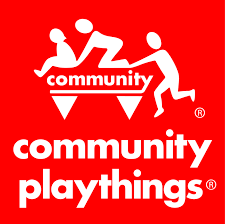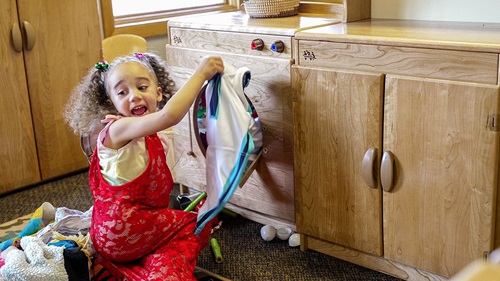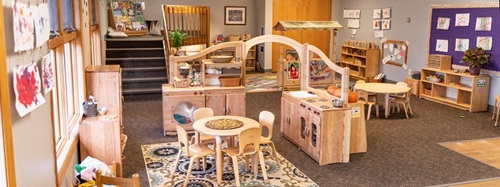Designing Quality Child Care Facilities
| October 2007The physical environment can either contribute to children's development and support staff and parent goals or create a permanent impediment to the operation of a high quality program. Designing a high-quality, developmentally appropriate child care facility is a highly complex task which requires specialized and unique skills. The design and layout of the physical environment, which includes the building, interior finishes, outdoor spaces, selection of equipment and room arrangement has a profound impact on children's learning and behavior and on teachers' abilities to efficiently do their jobs.
Children need age-appropriate physical environments that support and promote child-directed and child-initiated play. The environment must promote and positively support the child's interaction with space, materials and people. Teachers and caregivers also need highly functional, easy-to-use environments. When the environment supports both and is working for children and adults, it is easier for adults to focus on facilitating each child's play and learning.
Facilities that fail to support a high quality program are usually the result of well-meaning intentions gone awry. The problem can usually be traced to both the expertise of the design participants and the design process. The product can only be as good as the process that creates it and the expertise of the design participants.
The Challenges of Design
The first problem is that architects and designers who understand the principles of design often have little knowledge of child development and the operation of child care centers. Many times architects and designers create and choose designs that look good to them but may not be functional and practical in a child care center. Some buildings end up being architectural monuments that are over-designed with too much of the money being spent on the outside facade.
The more money that is being spent on the exterior shell of the building, the less money there will be for inside functional details like high quality finishes, appropriate furniture and equipment, adequate numbers of sinks and interior windows/doors - all details which can better support children and staff needs. Another limitation of architects is that they often do not understand that children just cannot adapt to inappropriate design like adults. Although there are anthropometric charts to assist them in making design elements the appropriate heights and depths, architects fail to understand, for example, that a toddler sink which is too high is unusable and one that is too low is unsafe since the children will climb inside. Children cannot adapt to design errors in height or depth. It simply must be age-appropriate the first time to work successfully.
The second problem that contributes to poor design is that the directors and teachers who know children and understand their needs rarely know how to translate their teaching and administrative skills to the design of space and the language used by architects and designers. Most child care practitioners may not be able to offer the best design solutions because they do not have a broad enough experience base. Due to being hampered by their existing paradigms, practitioners may be unaware of many solutions or may not be able to understand the downside of a particular solution. It is truly difficult to think of things you have never seen or read about. Add to the problem that practitioners do not speak the same language as architects and designers, and you will see why the multitude of details which can produce a high-quality, developmentally appropriate facility fall through the cracks.
The third problem that contributes to poor design has to do with the design process itself. The traditional design process is sequential like a relay race. The architect grabs the baton from the client, does the site and floor plan and passes the baton to the structural engineer. The structural engineer finishes their job and starts the baton on its path to a long line of specialists who, one by one, create the lighting, electrical and mechanical systems and interior design. Then the baton is passed to the staff to select and lay out the equipment. By then so many constraints have often been created by the architectural design that a quality equipment layout becomes impossible.
One of the big problems with this sequential relay approach is that each stage of design squeezes the stage after it, often closing off options that could have improved quality, reduced costs and sped up construction. Another problem is that each person has a vision only of his or her brief segment of the race; there is no unified vision to guide the design. Instead of a team working together to create a high quality, developmentally appropriate facility, the individuals do the best they can with what's been handed to them. They lose the benefits of a broad view and collaborative creativity.
Designing a children's facility this way makes as much sense as, in the words of physicist David Bohm, gluing together the fragments of a broken mirror to see a true reflection. By the time the picture begins to come together, it may be too late to change decisions made at the first leg of the race without costing too much time or money. Once the details have been entered on construction documents, any subsequent necessary changes will entail change orders costs, confusing details and possible construction delays.
The problem of this traditional approach is especially true with the design of children's facilities. By the time the owner is passed the baton, many design decisions, such as the floor plan, type of construction and finishes, have already been made. Often, the facility's very design is creating an unfriendly child and adult environment, but the flexibility to correct the underlying design problems has been lost.
Concurrent Design Approach
Our company believes that high quality, developmentally appropriate facilities are created through what is called concurrent design. Concurrent design means pulling together all the experts who design the facility and those who operate it at the same time. Everyone jumps into the sandbox at once, with specialists from many different areas participating as members of a multi-disciplinary, cross-functional design team from the beginning. Program goals, curriculum, children's needs, staff needs and parents' needs drive the concurrent design process. Other issues that need to be examined at the front end of the process are furniture and equipment and developmental and operating costs prior to designing the physical space. Everything impacts everything.
Function is examined in the process prior to looking at form. For example, many programs such as Head Start encourage parents to work in the classroom. Parent participation may necessitate more classroom square footage than state licensing standards require. State licensing requirements are only minimums and not necessarily quality standards. Outdoor areas designed for the inner city may have different durability and vandalism issues than an outdoor area in a rural area. Another example is that some cultural considerations will influence the design process. In a children's facility we designed for Muslims, the parents had mixed feelings about the use of outdoor sand boxes and conceded that they would not wish their children to use it unless it was sanitized regularly. Several cultures that we have worked with were concerned about privacy issues in the toddler changing table area. Families whom we worked with in South America seemed uncomfortable with large group areas. In order to be culturally sensitive, we adapt our design ideas accordingly. Cultural sensitivity and cultural competency is integral to good design.
The design team needs to be structured and sensitive to staff, parental and community input. The team should have members with specialized expertise in: child care, early childhood education, Head Start, Early Head Start, child development, children's play design, children's environmental design, infant/toddler care, architecture, landscape architecture, interior design, nature-based outdoor play space design, value engineering, acoustics for children, participatory design, start-up and operating budgets, equipment selection, cultural competency, universal design for children with disabilities and management of early childhood or Head Start centers.
Step 1
Whether you are working on a renovation or planning a new facility, the design process has a number of steps which are important for the practitioner to understand. The first step will be a preliminary site visit to meet with key staff, parents and sometimes children. From this meeting will evolve the design requirements such as the age and number of children, group sizes, staffing, curriculum goals, range of activities, designated spaces, square footage requirements, necessary regulations/standards and areas for aesthetics. At the time of the site visit, an inventory will be compiled and photographs taken of the site, existing structures, location of trees, identification of existing plant material, location of the sun, site drainage, and the condition of the building mechanicals and existing mechanical and electrical systems, if appropriate.
Step 2
The second step in the process is to create a conceptual design to find out what will work best for your program and to create an overall concept of the building or space. If this stage includes drawings for owner reaction, they will most likely be what are called bubble diagrams to work out adjacency and size issues with no detail. The next step is schematic design which will include a drawing that creates building specifics, relationships, basic furniture layouts, floor plans, mechanical and structural elements.
Step 3
The last step in the process is the development of the construction drawings and specifications and final selection of all furniture and equipment. These final construction documents are the specific plans which are used to obtain construction bids and permits and the general contractor will use to construct the building. Once construction or renovation begins, it is difficult and expensive to make changes. The set of prints and specifications that you have received contain many details which you will not need to understand; but more importantly they contain a myriad of details that must be executed properly for a high-quality facility, such as sink heights, toilet heights, door locations, sink depth, floor surfaces, window coverings, lighting and acoustics to name a few. All of these details were developed to best support the use of the space by children, staff and parents. Changes should not be made to these documents or the furniture and equipment without first discussing the ramifications of design changes for children and staff with the design team. An appropriate, high-quality building plan, specifications and furniture and equipment selection will be of little use if the facility is not built accordingly.
Designing and creating a high quality child care facility is a complex and lengthy process. By understanding the multi-faceted issues and complexities of designing children's environments, you can better select and work with a qualified design firm that can deliver the high quality, comprehensive and integrated design solutions that are required for a child care facility to meet staff's, parents', community's and children's needs.
References
Greenman, Jim, "So You Want to Build a Building? Dancing with Architects and Other Developmental Experiences--Part 3: Designing the Building", Living in the Real World, Child Care Information Exchange 1/92, Vol. 83, Pages 47-50.
Greenman, Jim, "Why Did It Turn Out This Way? How Buildings Go Wrong", Living in the Real World, Child Care Information Exchange, 3/92, Vol. 84, Pages 49-51.
Copyright © 2007 Vicki L. Stoecklin & Randy White. Reprinted with permission.






